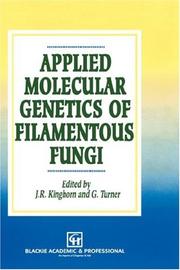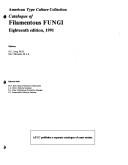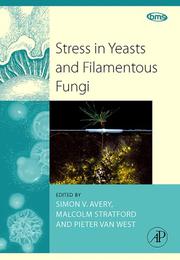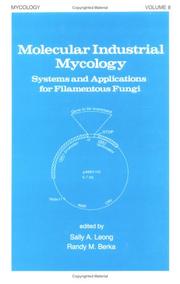| Listing 1 - 10 of 72 | << page >> |
Sort by
|
Book
ISBN: 051175227X Year: 1988 Publisher: Cambridge : Cambridge University Press,
Abstract | Keywords | Export | Availability | Bookmark
 Loading...
Loading...Choose an application
- Reference Manager
- EndNote
- RefWorks (Direct export to RefWorks)
This volume is an international compilation for biotechnologists of data on the location and use of filamentous fungi. The volume provides details of the location and scope of major culture collections around the world holding fungi; information on how to access their data, administration and safety, identification, culture and media recipes, preservation, patents, specialist services and international organization. The authors are international authorities who have combined with the resource centres to provide a source book for mycologists in industry, research establishments and universities.

ISBN: 0412033011 0751400580 Year: 1992 Publisher: London : Blackie,
Abstract | Keywords | Export | Availability | Bookmark
 Loading...
Loading...Choose an application
- Reference Manager
- EndNote
- RefWorks (Direct export to RefWorks)
Book
ISBN: 9518913277 Year: 1989 Publisher: Helsinki Foundation for biotechnical and industrial fermentation research
Abstract | Keywords | Export | Availability | Bookmark
 Loading...
Loading...Choose an application
- Reference Manager
- EndNote
- RefWorks (Direct export to RefWorks)

ISBN: 0930009398 Year: 1991 Publisher: Rockville (Md.) : American type culture collection,
Abstract | Keywords | Export | Availability | Bookmark
 Loading...
Loading...Choose an application
- Reference Manager
- EndNote
- RefWorks (Direct export to RefWorks)
Filamentous fungi --- Filamentous fungi --- Filamentous fungi --- Cultures and culture media --- Catalogs and collections --- Type specimens --- Catalogs and collections --- Catalogs and collections
Book
ISBN: 0713128577 Year: 1983 Publisher: London Arnold
Abstract | Keywords | Export | Availability | Bookmark
 Loading...
Loading...Choose an application
- Reference Manager
- EndNote
- RefWorks (Direct export to RefWorks)
Fungi. --- Filamentous fungi --- FUN Fungi & Lichenes --- Fungi --- techniques --- Filamentous fungi. --- Plant and Crop Sciences. Biology of Bacteria, Fungi and Plants -- Fungi --- ALLW.

ISBN: 128103830X 9786611038304 0080551270 012374184X 9780123741844 9780080551272 6611038302 Year: 2008 Publisher: London Boston Academic Press
Abstract | Keywords | Export | Availability | Bookmark
 Loading...
Loading...Choose an application
- Reference Manager
- EndNote
- RefWorks (Direct export to RefWorks)
Yeasts and filamentous fungi need to cope with stress, whether growing in the laboratory or in the natural environment, whether victims or offenders in interactions with other organisms. These considerations are discussed in this volume that coveres stress in the broad sense, within the context of mycology.* Includes discussions of the stresses associated with organism-organism interactions and stress under controlled conditions* Anthropogenic stress towards fungi in the environment and the impacts that such stressors may have on different organisms and communities in the wild are
Yeast fungi --- Filamentous fungi --- Effect of stress on. --- Microfungi --- Molds (Fungi) --- Yeasts --- Fungi --- Basidiomycetes --- Blastomycetes --- Endomycetales
Book
ISBN: 0128034912 012803470X Year: 2016 Publisher: Amsterdam, [Netherlands] : Academic Press,
Abstract | Keywords | Export | Availability | Bookmark
 Loading...
Loading...Choose an application
- Reference Manager
- EndNote
- RefWorks (Direct export to RefWorks)

ISBN: 0824783921 Year: 1991 Publisher: New York Marcel Dekker
Abstract | Keywords | Export | Availability | Bookmark
 Loading...
Loading...Choose an application
- Reference Manager
- EndNote
- RefWorks (Direct export to RefWorks)
Filamentous fungi --- Fungi --- Genetic Engineering. --- Industrial Microbiology. --- Molecular biology --- Mycology. --- Biotechnology. --- genetics. --- Methods.
Book
Year: 2014 Publisher: Frontiers Media SA
Abstract | Keywords | Export | Availability | Bookmark
 Loading...
Loading...Choose an application
- Reference Manager
- EndNote
- RefWorks (Direct export to RefWorks)
With the advent of recombinant DNA technology, expressing heterologous proteins in microorganisms rapidly became the method of choice for their production at laboratory and industrial scale. Bacteria, yeasts and other hosts can be grown to high biomass levels efficiently and inexpensively. Obtaining high yields of recombinant proteins from this material was only feasible thanks to constant research on microbial genetics and physiology that led to novel strains, plasmids and cultivation strategies. Despite the spectacular expansion of the field, there is still much room for progress. Improving the levels of expression and the solubility of a recombinant protein can be quite challenging. Accumulation of the product in the cell can lead to stress responses which affect cell growth. Buildup of insoluble and biologically inactive aggregates (inclusion bodies) lowers the yield of production. This is particularly true for obtaining membrane proteins or high-molecular weight and multi-domain proteins. Also, obtaining eukaryotic proteins in a prokaryotic background (for example, plant or animal proteins in bacteria) results in a product that lack post-translational modifications, often required for functionality. Changing to a eukaryotic host (yeasts or filamentous fungi) may not be a proper solution since the pattern of sugar modifications is different than in higher eukaryotes. Still, many advances in the last couple of decades have provided to researchers a wide variety of strategies to maximize the production of their recombinant protein of choice. Everything starts with the careful selection of the host. Be it bacteria or yeast, a broad list of strains is available for overcoming codon use bias, incorrect disulfide bond formation, protein toxicity and lack of post-translational modifications. Also, a huge catalog of plasmids allows choosing for different fusion partners for improving solubility, protein secretion, chaperone co-expression, antibiotic resistance and promoter strength. Next, controlling culture conditions like temperature, inducer and media composition can bolster recombinant protein production. With this Research Topic, we aim to provide an encyclopedic account of the existing approaches to the expression of recombinant proteins in microorganisms, highlight recent discoveries and analyze the future prospects of this exciting and ever-growing field.
Environmental sciences. --- Inclusion Bodies --- Escherichia coli --- Filamentous fungi --- Microalgae --- Recombinant Proteins --- Microorganism --- fusion tags --- yeast
Book
Year: 2014 Publisher: Frontiers Media SA
Abstract | Keywords | Export | Availability | Bookmark
 Loading...
Loading...Choose an application
- Reference Manager
- EndNote
- RefWorks (Direct export to RefWorks)
With the advent of recombinant DNA technology, expressing heterologous proteins in microorganisms rapidly became the method of choice for their production at laboratory and industrial scale. Bacteria, yeasts and other hosts can be grown to high biomass levels efficiently and inexpensively. Obtaining high yields of recombinant proteins from this material was only feasible thanks to constant research on microbial genetics and physiology that led to novel strains, plasmids and cultivation strategies. Despite the spectacular expansion of the field, there is still much room for progress. Improving the levels of expression and the solubility of a recombinant protein can be quite challenging. Accumulation of the product in the cell can lead to stress responses which affect cell growth. Buildup of insoluble and biologically inactive aggregates (inclusion bodies) lowers the yield of production. This is particularly true for obtaining membrane proteins or high-molecular weight and multi-domain proteins. Also, obtaining eukaryotic proteins in a prokaryotic background (for example, plant or animal proteins in bacteria) results in a product that lack post-translational modifications, often required for functionality. Changing to a eukaryotic host (yeasts or filamentous fungi) may not be a proper solution since the pattern of sugar modifications is different than in higher eukaryotes. Still, many advances in the last couple of decades have provided to researchers a wide variety of strategies to maximize the production of their recombinant protein of choice. Everything starts with the careful selection of the host. Be it bacteria or yeast, a broad list of strains is available for overcoming codon use bias, incorrect disulfide bond formation, protein toxicity and lack of post-translational modifications. Also, a huge catalog of plasmids allows choosing for different fusion partners for improving solubility, protein secretion, chaperone co-expression, antibiotic resistance and promoter strength. Next, controlling culture conditions like temperature, inducer and media composition can bolster recombinant protein production. With this Research Topic, we aim to provide an encyclopedic account of the existing approaches to the expression of recombinant proteins in microorganisms, highlight recent discoveries and analyze the future prospects of this exciting and ever-growing field.
Environmental sciences. --- Inclusion Bodies --- Escherichia coli --- Filamentous fungi --- Microalgae --- Recombinant Proteins --- Microorganism --- fusion tags --- yeast
| Listing 1 - 10 of 72 | << page >> |
Sort by
|

 Search
Search Feedback
Feedback About
About Help
Help News
News